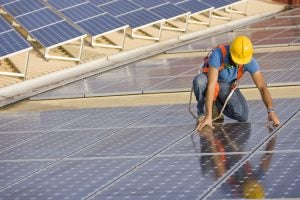Recommendations for a resilient grid, no federal coal bailout required
 By Michael Panfil, Rama Zakaria
By Michael Panfil, Rama Zakaria
In the past year, the U.S. Department of Energy (DOE) has used the issue of grid resilience as cover for an aggressive campaign to funnel a multi-billion-dollar yearly bailout to the owners of old, uneconomic coal and nuclear power plants. Although this DOE effort was rightly rejected by the Federal Energy Regulatory Commission (FERC) in January, the issue of resilience remains.
In denying DOE’s proposal, FERC (the agency responsible for overseeing our nation’s electric grid) asked regional grid operators to report practices they are currently implementing to ensure a reliable, resilient electric grid. In March, grid operators filed their reports, which generally concluded that the grid is resilient and we don’t need uneconomic coal and nuclear plants to keep the lights on.
Today, Environmental Defense Fund (EDF) – alongside numerous other stakeholders from business, academia, industry, and public interest organizations – submitted to FERC individual and joint comments on these grid operator reports and the topic of grid resilience.
[Tweet “Recommendations for a resilient grid, no federal coal bailout required”]
Our comments make clear that dirty, costly coal power is unnecessary for a well-functioning electric grid, and DOE’s fundamental approach – which has focused on mandating profit-guarantees for politically-favored coal – has no place in America’s competitive power markets. In addition, EDF’s joint comments made several recommendations to support a cleaner, more affordable, reliable, and resilient electric grid, including the following:
- Resilience improvements should focus on the wires, not generation. The vast majority of outages (according to DOE, over 90 percent, in fact), are caused because distribution lines, which connect the electric grid to customers, go down. A focus on power plants, rather than the wires connecting the grid, is thus misplaced.
- Don’t lose sight of what matters. FERC’s legal responsibility is to make sure the electric grid delivers reliable, affordable power to Americans – not to pick which private companies win or lose in the process. Any action by FERC or grid operators should be done with this in mind: If customers don’t need it, don’t do it. And as a recent report on the topic concludes, the most effective resilience measures should focus on state-regulated distribution systems.
- Create a pathway for more flexibility on the grid. The grid of today and tomorrow needs fast-acting resources like energy storage and demand response that can respond quickly to variations in energy supply and demand. FERC recently took steps to ensure energy storage has the same opportunity to compete in our competitive power markets as resources like gas and coal, but has not yet provided a similar pathway for other distributed energy resources. Our comments recommend that FERC quickly and concretely take steps to provide access for these resources to improve grid resilience.
- Support clean, distributed energy resources. Because most outages occur on the distribution grid, improvements on or near the customer side of the grid can be particularly valuable. Measures taken to support distributed energy resources like rooftop solar or microgrids can thus support local communities and provide clean, affordable electricity to the grid.
- Respect regional differences. There are six FERC-regulated grid operators in the United States. What works for one region may not work well for another. Respecting, encouraging, and learning from regional differences can support a more innovative, dynamic grid.
EDF’s comments today use the grid operator reports as an opportunity to recommend how FERC should consider resilience as our electric grid continues to evolve and adapt. Separately, we’re also filing comments on new, more efficient ways for pipelines and electric generators to contract with one another.
EDF will continue to engage as the docket before FERC unfolds. How FERC will act, however, is still unknown.
Market forces and technology are increasingly making old, dirty power plants uneconomic – but the Trump administration is committed to saving coal at the expense of the American people and their health. Our hope is that FERC will be a voice of reason in this debate around resilience, upholding its role as an unbiased and evidence-driven government entity that delivers affordable, reliable electricity without choosing sides based on politics.












2 Comments
The EDF blog on grid resilience is an important contribution. It is quite correct in saying that resilience is much less dependent upon generation than upon other parts of the electric grid. Grid operators have shown that they can accomodate unscheduled generator outages by calling upon other resources and rerouting power.
Grid resilience can be enhanced by ensuring that the existing grid is well maintained to avoid disasterous situations, such as the one in Puerto Rico from Hurricanes Irma and Maria (https://goo.gl/xHDrBi). Also, as noted in the blog, resilience can be increased by having generation capabilities (e.g., distributed energy resources) and energy storage closer to distribution grids. We should also encourage greater demand-side resource control, such as demand-response programs. Finally, distribution grids can be made more resilient through new designs that permit rerouting of power around failed facilities.
Thanks Ken for taking the time to read our blog post and comment. We certainly agree and are always interested to hear about new clean energy technologies and innovative designs that can help enhance grid resilience.